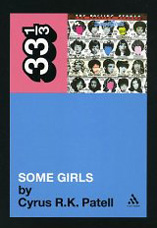 Book Reviews: October 2011

“Once upon a time—before they transformed themselves into the multi-billion-dollar corporate conglomerate that they are today—[the Rolling Stones] made music that was very, very good. The band produced a string of albums that captured—and slyly commented on—the turbulent cultural dynamics of the Sixties and Seventies. Some Girls is the last of those.” So observes New York University professor Cyrus R. K. Patell in Some Girls (Continuum, 2011, Pp. 192, $12.95), another excellent addition to the noted 33 1/3 Series. Although recorded in Paris, Some Girls, Dr. Patell convincingly argues, is a “New York album.” Many of the LP’s songs reference the Big Apple and its myriad mid-Seventies problems, which included financial chaos, rampant seediness, the Son of Sam murders, arson outbreaks, and the July 13, 1977, total blackout. “Shattered,” anyone? “What a mess/This town’s in tatters/I’ve been shattered/My brain’s been battered/Splattered all over Manhattan.” The Stones faced daunting challenges of their own during this period, including the tragic death of baby Tara Richards, Keith’s struggle with substance abuse, the legal uncertainty following his Canadian drug bust, the disintegration of the Mick-Bianca and Keith-Anita relationships, and the threats posed by disco and punk. Had the Glimmer Twins become old and outdated with “nothing to offer the kids anymore,” as Sex Pistol Johnny Rotten sneered? “At the end of the Seventies,” Patell contends, “for both the city and the band, simply surviving seemed to be the name of the game.” Sucking in the Seventies, indeed. The Stones, however, came out swinging, releasing the landmark Some Girls (number 269 on Rolling Stone magazine’s 500 Greatest Albums of All Time) in June 1978. Want disco? Slip on the infectious “Miss You,” which reached number 3 in the UK and number 1 in the States. Need a rejoinder to the torn t-shirt, safety pin crowd? (“We’ve got to out-punk the punks,” Keith explained.) Try out “Lies,” “Respectable,” and “When the Whip Comes Down,” which, Patell maintains, lets “us know that we’ve left the world of…Studio 54 and gone downtown to the Lower East Side and the punk scene of CBGB’s.” And that’s not even mentioning the infamous title track, the Bakersfield side splitter “Far Away Eyes,” “Just My Imagination” (the superb Temptations cover), Keith’s open G classic “Before They Make Me Run,” and, of course, “Beast of Burden,” one of the group’s best ever ballads. Understandably proud of Some Girls, Ronnie Wood declared, “There aren’t any filler tracks on this album. The band was most aware of avoiding that.”
A handful of typographical errors and the lack of an index detract from Professor Patell’s study, though just a bit. Overall, this is an exceptionally well researched, erudite, and entertaining volume. Shadoobie.
 |
 "The Rolling Stones' Some Girls" (33 1/3 Series)
"The Rolling Stones' Some Girls" (33 1/3 Series)